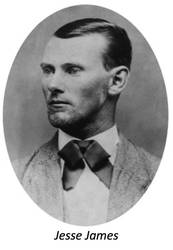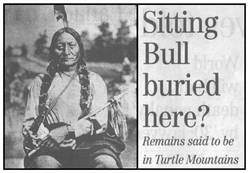Jesse James

I grew up fairly close the U.S. border. About forty years ago I was told the story of how one of the pistols in the hands of a local collector had once belonged to Jesse James, who had come to our neighbourhood to escape pursuit south of the border. Many years later I was shown a house where members of the James Gang had supposedly hung out. Horace Forbes, the son of a district pioneer, once claimed that he witnessed two heavily armed men were talking with the hired girl. He says, “These were the James brothers, Frank and Jesse, on one of their trips into Canada”. There is a story about a wife of one of the James brothers who settled in the Napinka area and gave a set of pistols to the local blacksmith.
After some research I found out that James was rumoured to have buried gold in Ontario, belonged to a secret society in Quebec, and spent some time in Portage La Prairie. He got around. I also learned that Jesse James was killed in 1882, before most of the reported Canadian incidents were supposed to have occurred, and there is no evidence that he was ever north of Missouri or Kentucky after 1876.
Where do such stories originate?
I think they start with a mixture of plausibility and imagination and are nurtured by the media. In 1901, on the twenty-fifth anniversary of celebrated bank robbery in Northfield Minnesota, the story was widely re-told in our local press.
They are, above all, border stories.
A Well-Travelled Horse.
Then there’s the one about General Custer’s horse.
The story is that a horse used by General Custer at the Battle of Little Bighorn, complete with saddle, was brought to the Wakopa area by Dakota warriors who were still wearing scalps of the Seventh Cavalry on their belts.
Sounds a bit far-fetched, but according to www.american-tribes.com, Noisy Walker, the son of the Wahpekute Chief Inkpaduta, captured Custer’s horse after the battle. We have good reason to believe that Inkpaduta and some of his family came to southwestern Manitoba soon after Little Bighorn.
So while there is no proof, at least there is a rationale behind the story that takes it past the rumour stage. We might I suppose consider it a plausible theory. As with the Jesse James story, we should find it interesting that there is no mention in the contemporary press. There were however all kinds of stories about the battle and the flight of warriors to Canada.
Sitting Bull’s Bones
Jerome First, a Dakota from Montana, is a great grandson of Medicine Bear, who was in turn a close friend of Sitting Bull. He insists that the body of Sitting Bull, who was killed near Fort Yates North Dakota in 1890, was smuggled in to Canada and buried on the Turtle Mountain. Most historians believe that the famous chief was buried at Fort Yates, but Mr. First believes that the burial was faked. Is this new theory credible? The Winnipeg Free Press on Feb 24, 2007, devoted a page to the story.

Once again – more of a theory than a rumour. There has been some thought put into the suggestion. Still one has to wonder about the role of wishful thinking. The connection between the Dakota and Turtle Mountain is well established and it makes an intriguing story.
The Case of the Smuggled Gatling Gun
Mary Johnson, writing in Beckoning Hills tells us that:
“In 1885, Indians, pretending to be carrying the body of an Indian chief to a northwest burial ground, attempted to smuggle a Gatling gun from Minneapolis to help in the Riel Rebellion. They came by the Missouri Trail and along the old Commission Trail, but were spotted and captured by the Border Patrol just west of Wakopa.”
She is not alone in reporting this story. We also find it in the Killarney local history. James Henderson’s, a respected pioneer, offered a version of the story that is full of details.
He names the people involved; Sam Kellam and Bill Barber, who he says had been sworn in as border guards to prevent any such incursions. He tells how a band of “Indians” (unidentified any further) were accosted when Will Moon, an Assiniboine who was working with the border guards, became suspicious. It seems they were carrying what they said was a coffin containing an old Chief that they intended to bury at the headwaters of Turtle Head Creek. They surrendered the coffin without a fight, despite outnumbering the border guards, and the Gatling Gun was discovered in the coffin.
But did it really happen?
One problem is that Mr. Henderson doesn’t tell us who told him the story and he doesn’t indicate that he witnessed any of the events first hand.
Once again the press at the time was full of stories about the Gatling Gun, and full of stories about the threat and possibility of some sort of uprising. In 1885, 21 mentions are made of the term “Gatling Gun” in Brandon and other Manitoba newspapers, but not one report mentions the term in any context other than its use at Batoche.
Along with that we find that there were very real efforts by the Northwest Mounted Police to counteract the perceived threat. The stories about Border Guards and arming local farmers are fairly consistent.
Border Myths?
So what are we to make of these stories? They seem akin to so-called urban myths. They grow out of a degree of plausibility and we want them to be true. They fit a narrative – reflect our hopes, fears and daydreams. They attract our attention to the times and they illustrate the fallibility of memory as a component of the historical record.
Maybe all stories that stimulate an interest in a subject are good stories. If it’s possible that Al Capone spent his spare time in Moose Jaw, well maybe our border stories are worth a listen.
. . . . .
Author: Ken Storie
Sources:
Boissevain History Book Committee. Beckoning Hills Revisited. “Ours is a Goodly Heritage” Morton – Boissevain 1881 – 1981. Altona. Friesen Printing, 1981
Brenda History Committee. Bridging Brenda Vol. 1. Altona. Friesen Printers, 1990
Deloraine History Book Committee. Deloraine Scans a Century 1880 - 1980: Altona. Friesen Printers, 1980
Winnipeg Free Press. 24 Feb. 2007
Photos:
Wikipedia
